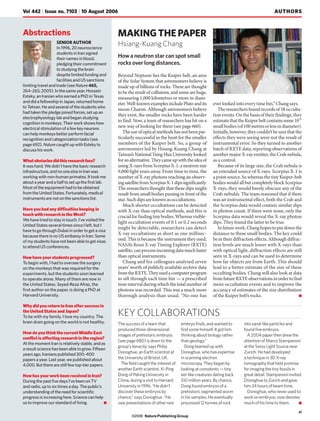More Related Content
Similar to Nature August 10 interview (20)
Nature August 10 interview
- 1. Abstractions
Beyond Neptune lies the Kuiper belt, an area
of the Solar System that astronomers believe is
made up of billions of rocks. These are thought
to be the result of collisions, and some are huge,
measuring 1,000 kilometres or more in diam-
eter. Well-known examples include Pluto and its
moon Charon. Although astronomers believe
they exist, the smaller rocks have been harder
to find. Now, a team of researchers has hit on a
new way of looking for them (see page 660).
Theuseofopticalmethodshasnotbeenpar-
ticularly successful in the hunt for the smaller
members of the Kuiper belt. So, a group of
astronomers led by Hsiang-Kuang Chang at
Taiwan’s National Tsing Hua University looked
foranalternative.Theycameupwiththeideaof
using X-rays from Scorpius X-1, a neutron star
9,000 light years away. From time to time, the
number of X-ray photons reaching an observ-
ingsatellitefromScorpiusX-1dipssignificantly.
The researchers thought that these dips might
result from small bodies passing in front of the
star. Such dips are known as occultations.
Much shorter occultations can be detected
with X-ray than optical methods, and this is
crucialforfindingtinybodies.Whereasvisible-
light occultation events of 0.1 or 0.2 seconds
might be detectable, researchers can detect
X-ray occultations as short as one millisec-
ond. This is because the instrument they used,
NASA’s Rossi X-ray Timing Explorer (RXTE)
satellite,canprocessincomingdatamuchfaster
than optical instruments.
Chang and his colleagues analysed seven
years’ worth of publicly available archive data
fromtheRXTE.Theyusedacomputerprogram
to sift through each time bin — a prescribed
timeintervalduringwhichthetotalnumberof
photons was recorded. This was a much more
thorough analysis than usual. “No one has
ever looked into every time bin,” Chang says.
The researchers found records of 58 occulta-
tion events. On the basis of their findings, they
estimatethattheKuiperbeltcontainssome1015
smallbodies(of100metresorlessindiameter).
Initially, however, they couldn’t be sure that the
effects they were seeing were not the result of
instrumental error. So they turned to another
batch of RXTE data, reporting observations of
another major X-ray emitter, the Crab nebula,
as a control.
Because of its large size, the Crab nebula is
an extended source of X-rays. Scorpius X-1 is
a point source. So whereas the tiny Kuiper-belt
bodies would all but completely block Scorpius
X-rays, they would barely obscure any of the
Crab nebula’s. The team reasoned that if there
was an instrumental effect, both the Crab and
the Scorpius data would contain similar dips
in photon count. If there were none, only the
Scorpius data would reveal the X-ray photon
dips. They found the latter to be true.
Infuturework,Changhopestopindownthe
distance to these small bodies. The key could
beintheirdiffractioneffects.Althoughdiffrac-
tion levels are much lower with X-rays than
with optical light, diffraction effects are still
seen in X-rays and can be used to determine
how far objects are from Earth. This should
lead to a better estimate of the size of these
occulting bodies. Chang will also look at data
fromfutureRXTEobservationsinordertofind
more occultation events and to improve the
accuracy of estimates of the size distribution
of the Kuiper belt’s rocks. ■
MAKINGTHEPAPER
Hsiang-Kuang Chang
How a neutron star can spot small
rocks over long distances.
SENIOR AUTHOR
In1996,20neuroscience
studentsinIransigned
theirnamesinblood,
pledgingtheircommitment
tostudyingthebrain
despitelimitedfundingand
facilitiesandUSsanctions
limitingtravelandtrade(seeNature465,
264–265;2005).Inthesameyear,Hossein
Esteky,anIranianwhoearnedaPhDinTexas
anddidafellowshipinJapan,returnedhome
toTehran.Heandseveralofthestudentswho
hadtakenthepledgejoinedforces,setupan
electrophysiologylabandbeganstudying
cognitioninmonkeys.Theirworkshowshow
electricalstimulationofafewkeyneurons
canhelpmonkeysbetterperformfacial
recognitionandcategorizationtasks(see
page692).NaturecaughtupwithEstekyto
discusshiswork.
Whatobstaclesdidthisresearchface?
Itwashard.Wedidn’thavethebasicresearch
infrastructure,andnooneelseinIranwas
workingwithnon-humanprimates.Ittookme
aboutayearandahalftosetupthefirstlab.
Mostoftheequipmenthadtobeobtained
fromtheUnitedStates.Fortunately,medical
instrumentsarenotonthesanctionslist.
Have you had any difficulties keeping in
touch with research in the West?
Wehavetriedtostayintouch.I’vevisitedthe
UnitedStatesseveraltimessinceIleft,butI
havetogothroughDubaiinordertogetavisa
becausethereisnoUSembassyinIran.Some
ofmystudentshavenotbeenabletogetvisas
toattendUSconferences.
How have your students progressed?
To begin with, I had to oversee the surgery
on the monkeys that was required for the
experiments, but the students soon learned
to operate alone. Many of them are now in
the United States. Seyed-Reza Afraz, the
first author on the paper, is doing a PhD at
Harvard University.
Why did you return to Iran after success in
the United States and Japan?
To be with my family. I love my country. The
brain drain going on the world is not healthy.
How do you think the current Middle East
conflict is affecting research in the region?
AtthemomentIranisrelativelystable,andas
aresultsciencehasbeenabletogrow.Fifteen
yearsago,Iranianspublished300–400
papersayear.Lastyear,wepublishedabout
4,000.Buttherearestillfewtop-tierpapers.
How has your work been received in Iran?
DuringthepastfivedaysI’vebeenonTV
andradio,uptosixtimesaday.Thepublic’s
understandingoftheneedforscientific
progressisincreasinghere.Sciencecanhelp
ustoimproveourstandardofliving. ■
The success of a team that
produced three-dimensional
images of prehistoric embryos
(see page 680) is down to the
group’s tenacity, says Philip
Donoghue, an Earth scientist at
the University of Bristol, UK.
The field caught the interest of
another Earth scientist, Xi-Ping
Dong of Peking University in
China, during a visit to Harvard
University in 1996. “He didn’t
discover these embryos by
chance,” says Donoghue. “He
saw presentations of other rare
embryo finds, and wanted to
find some himself. It got him
thinking about biology rather
than geology.”
Dong teamed up with
Donoghue, who has expertise
in scanning electron
microscopy. They began by
looking at conodonts — tiny
eel-like creatures dating back
510 million years. By chance,
Dong found embryos of a
prehistoric segmented worm
in his samples. He eventually
processed 12 tonnes of rock
into sand-like particles and
found five embryos.
A 2004 paper then drew the
attention of Marco Stampanoni
at the Swiss Light Source near
Zurich. He had developed
a technique in 3D X-ray
tomography that held promise
for imaging the tiny fossils in
great detail. Stampanoni invited
Donoghue to Zurich and gave
him 24 hours of beam time.
Donoghue, who never used to
work on embryos, now devotes
much of his time to them. ■
KEY COLLABORATIONS
xi
Vol 442 | Issue no. 7103 | 10 August 2006 AUTHORS
NaturePublishing Group©2006
